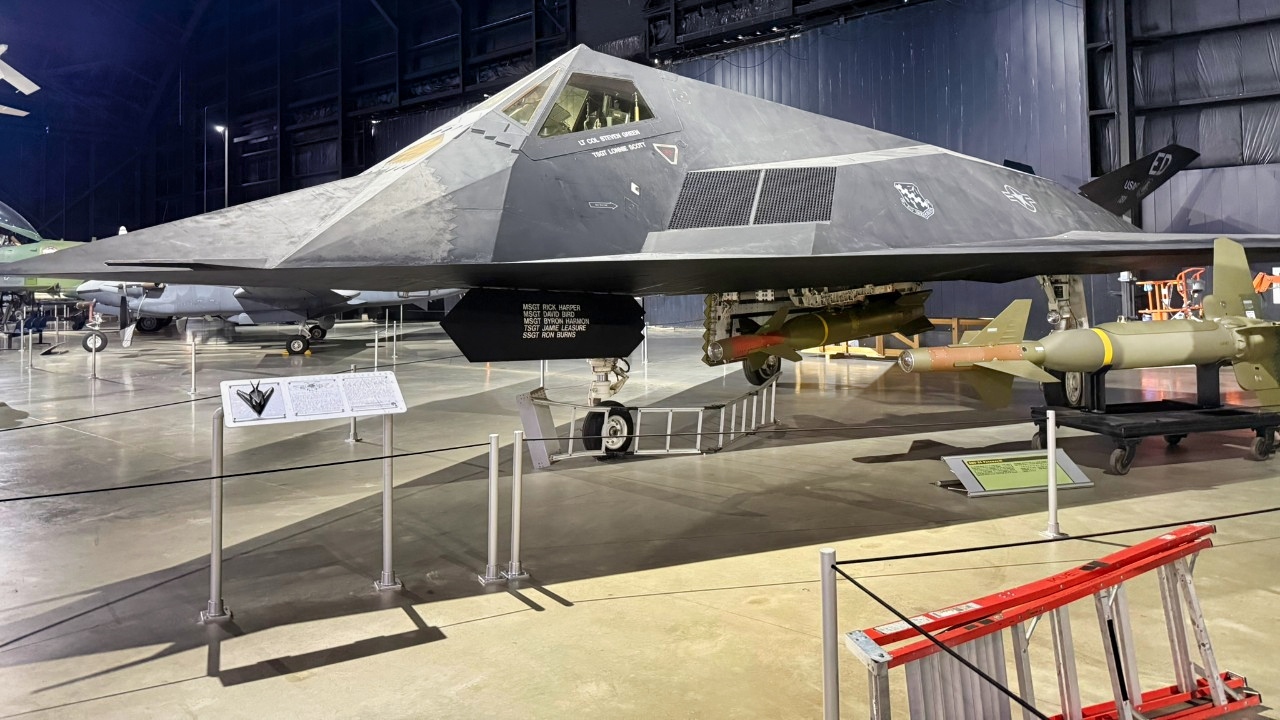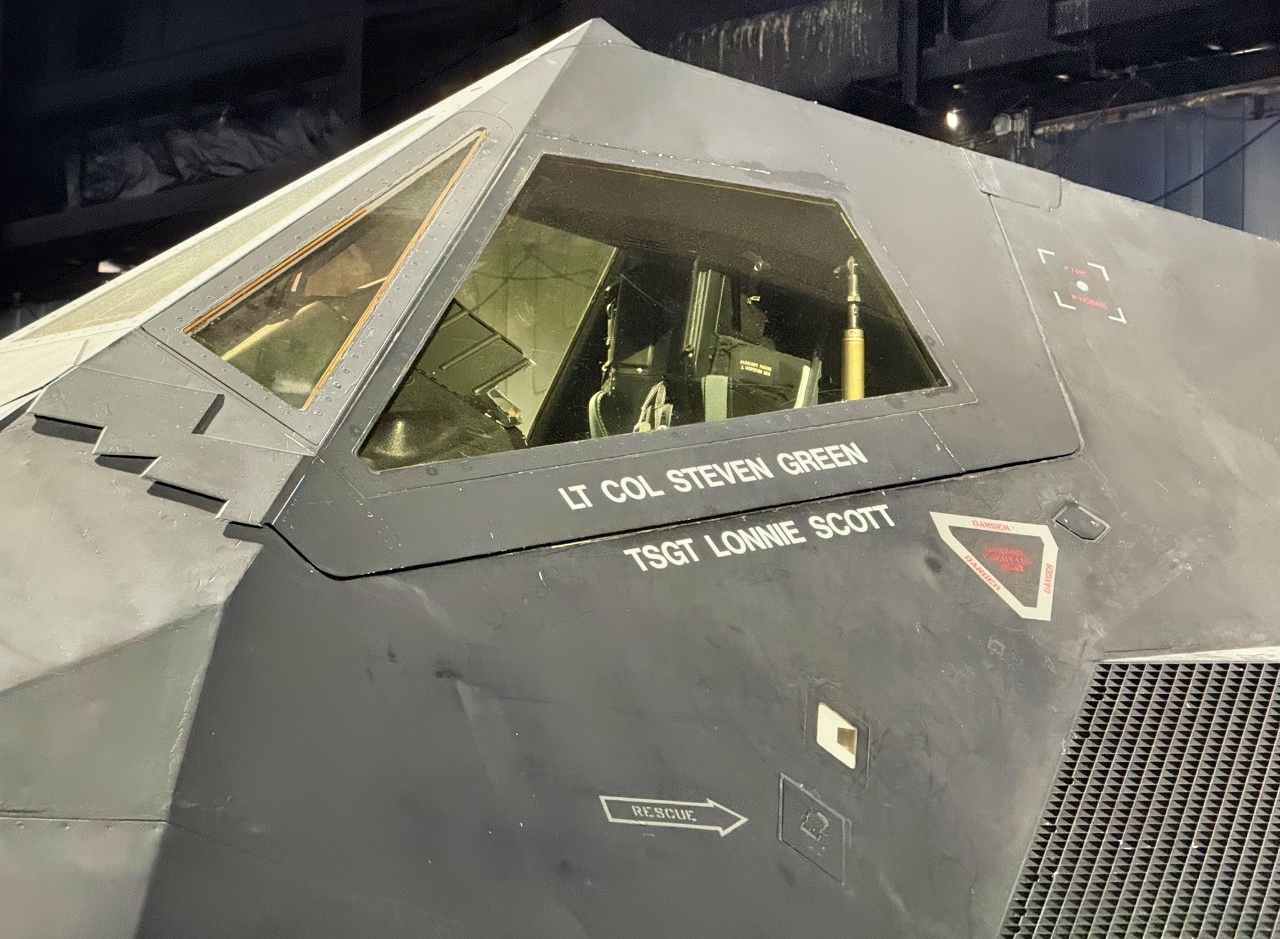Key Points and Summary – Many nations market new fighters as “stealth,” but most only manage radar signature instead of achieving true low observability.
-U.S. programs defined successive generations—from angled F-117 to blended F-35—and now aim beyond shaping with Boeing’s F-47/NGAD.

F-117 Nighthawk Stealth Fighter. Image taken on 7/19/2025 in Dayton, Ohio, USAF Museum.
-Core rules still apply: avoid concave reflectors, bury inlets, and control seams with extreme precision and materials.
-Claims that canard-equipped designs rival U.S. standards don’t survive physics; forward surfaces and sloppy joins raise RCS significantly.
-This piece explains what real stealth means, why “managed RCS” isn’t enough, and how NGAD points to the next era of survivability and air dominance.
Stealth: Truly Made in USA
WARSAW, POLAND – It has become a common practice among fighter aircraft designers and producers outside the United States to present new designs and claim them to be stealthy.
To some degree, according to US experts in this esoteric field of aerospace technology, they can describe what they have developed as “stealthy,” but most do not meet US standards in this regard.
Stealth is a term used very broadly in many instances and often inaccurately. The airplanes these other nations have designed are, in the words of those specialists who spoke to National Security Journal, “platforms where the signature or radar cross section (RCS) of the aircraft has been managed or mitigated. They may look like a stealthy aircraft, but in reality, they are far more visible on radar than we are led to believe.

F-117 Up Close at USAF Museum. Image Credit: National Security Journal.
“Managed means that they have not really made the aircraft stealthy but have reduced it to something less than that of a conventionally-shaped fourth-generation design in the generation of the F-15 or the Dassault Rafale,” said one RCS designer who spoke to us.
Specialists we spoke to shared a common observation about the concept of “being stealthy” in the aircraft design business. The combined wisdom of these persons could fill volumes, but some of the basic precepts of this technology should be kept in mind when using that description.
One is that there are distinct generations of stealth design.
Generations
The first technology called “stealth” was announced by then-Secretary of Defense Harold Brown during a Pentagon news conference on August 22, 1980. Stealth, as it was described at the time, could reduce the RCS of an aircraft to approximately the size of a bird. This design would allow a bomber to penetrate deep into enemy airspace without being detected, intercepted, or shot down.
“It is not too soon to say that by making existing air defense systems essentially ineffective, this alters the military balance significantly,” Brown said. But what the SecDef did not say was that a stealth fighter prototype, developed under a project known as Have Blue, and which would provide the data to develop the F-117A Nighthawk, had been flying since 1977, or that the program to develop the B-2 Spirit was already under contract.
The basis for stealth design in these early-generation designs was to build an aircraft designed with convex versus concave surfaces.
A concave surface reflects radar waves back in the direction of arrival, which is the radar transmitter. Stealth aircraft designs avoid this above all other considerations. Concave surfaces of conventional, non-stealthy aircraft are typically engine inlets, right angles where wings join the fuselage, open bomb bays, and the cockpit if the windscreen is transparent to radar signals.
Convex surfaces scatter the radar waves in widely separated vectors, thereby reducing the energy reflected back to the source radar’s receiver. The B-2 stealth bomber is shaped like a flying wing, which is a convex shape when viewed from almost any direction. Smaller features, such as the engine air inlets, are specially designed to reflect signals in a direction other than that of the illuminating radar.
Beginning before today’s era, US industry built three successive generations of aircraft developed by the Skunk Works, otherwise known as the Lockheed Advanced Development Projects group, in Palmdale, California. The SR-71 Blackbird, the F-117 Nighthawk, and the F-35 Lightning II were all developed by the Skunk Works, but they were designed in different decades and for distinctly different mission roles.

A U.S. Air Force F-35A Lightning II assigned to the 60th Fighter Squadron, flies overhead after conducting a live weapons drop at Camp Shelby, Miss., Oct 25, 2023. During the exercise, pilots tested various munitions including the GBU-12s, GBU-31v1s, and 362 rounds of 25mm Training Munitions from the gun.
The SR-71, which has been retired from service, was a high-speed, high-altitude reconnaissance plane known for its unmatched speed and performance.
One of the most famous Skunk Works products was the F-117A, the first operational combat stealth aircraft. Designed before the 360-degree computer-modelled and shaped, blended body techniques now used in stealth designs, it was a ground-attack platform built using flat, angled surfaces covered in radar-absorbing material (RAM).
Today’s F-35 is a current-generation, multi-role stealth fighter that epitomizes the generation of stealth technology that goes beyond the F-117A. It combines the blended-body/no reflective surfaces planform with internal computing power that creates both stealth and superior maneuverability.
Future Shock (and Awe) in Stealth Design
The next chapter beyond these evolutionary aircraft is the US Air Force’s Next-Generation Air Dominance (NGAD) program.
This 6th-generation aircraft, now designated the F-47, will be the first stealthy aircraft designed by Boeing and is intended to move far beyond the F-35, into territory where, literally, “no man has gone before.”
It will be bereft of any vertical control surfaces and will, according to one person close to the program who spoke to National Security Journal, “Be based on concepts of stealth that go beyond just the shaping of an aircraft fuselage and the techniques we know as the keys to low RCS today,” he said.
“I cannot be specific about these newer technologies, which have not been part of the basic properties of a stealthy aircraft up to now. What I can say is that the ‘seams’ of where different sections of aircraft, like the F-47 or the Navy’s F/A-XX, are joined will take on an entirely new significance. They will have to be ultra precise for reasons other than just not creating a reflective surface,” he said.
“There are other countries out there who think they are making stealthy designs,” he continued. “There is one in particular that has an aircraft they say falls into this category, and that aircraft has big movable canards mounted forward of the cockpit section. They may think you can mitigate these as being radar reflectors, but there is no way to do that. Whatever they say, they will never be stealthy in a way that the US military currently defines it.”
About the Author: Reuben F. Johnson
Reuben F. Johnson has thirty-six years of experience analyzing and reporting on foreign weapons systems, defense technologies, and international arms export policy. Johnson is the Director of Research at the Casimir Pulaski Foundation. He is also a survivor of the Russian invasion of Ukraine in February 2022. He worked for years in the American defense industry as a foreign technology analyst and later as a consultant for the US Department of Defense, the Departments of the Navy and Air Force, and the governments of the United Kingdom and Australia. In 2022-2023, he won two awards in a row for his defense reporting. He holds a bachelor’s degree from DePauw University and a master’s degree from Miami University in Ohio, specializing in Soviet and Russian studies. He lives in Warsaw.
More Military
China’s New J-20S Is the Double Trouble Problem for the F-35
The F-35 Is the iPhone of Stealth Fighter Planes











Jim
September 10, 2025 at 11:24 am
I sure hope so. Having the best military technology available is key to “Peace through Strength.”
But then there is the reality, well known, of defense contractors over promising and underdelivering and overpricing on their claims of superiority.
The F-35 is a classic example.
There are the on the ground maintenance and readiness issues which are well known.
But the key claim of stealth maybe overblown. There is evidence advanced radar systems developed by the Russians, Chinese, and possibly even Iran are able to “see” the F-35. That maybe the exact reason Israeli F-35’s mostly stayed out of Iranian airspace.
Certainly, Israeli F-35’s never flew over the skies of Tehran as many supposed they did.
Now, air to air in flight radar systems incorporated into enemy aircraft may not be able to lock on to F-35’s, but again, we just don’t know until first contact with the enemy.
All in all, America needs cutting edge technology, but the race to stay on top is getting harder all the time.
Until F-35 are subject to missions against peer competitors in full combat mode, there will be some doubt which can’t be dispelled.
It’s called the uncertainty factor.
Librarian
September 10, 2025 at 2:35 pm
Boeing???
Am I the only on that see a possible issue there?